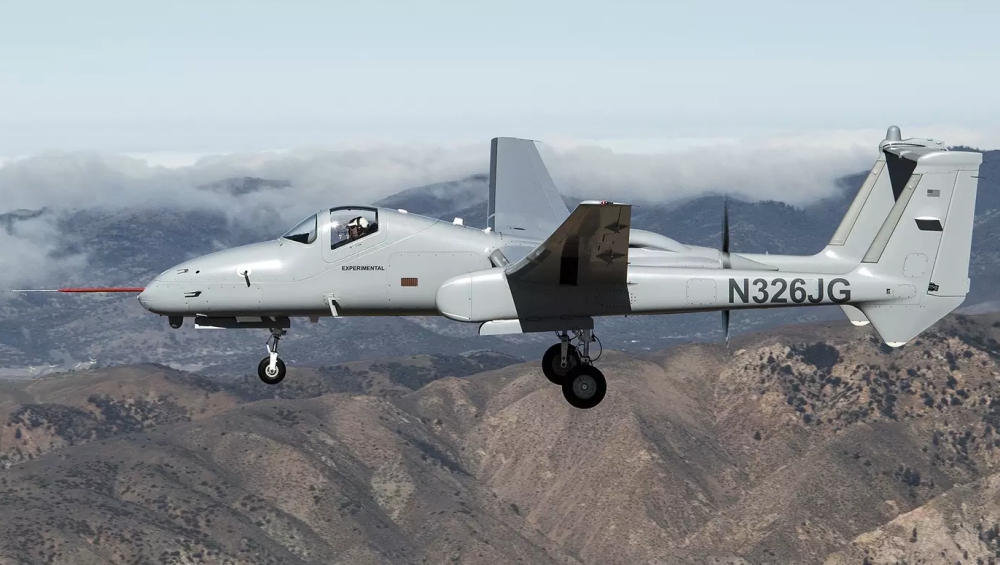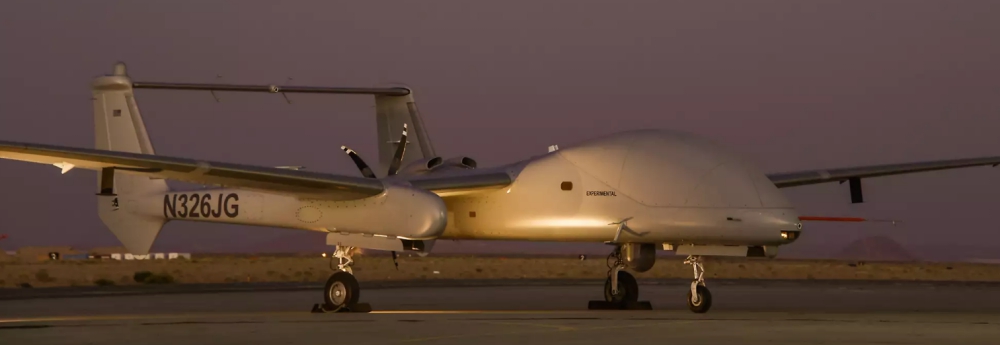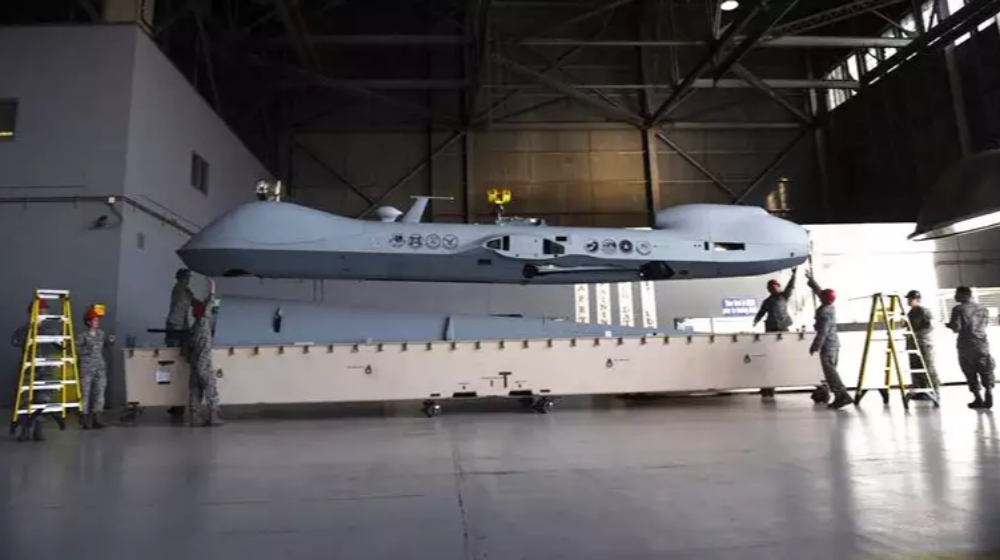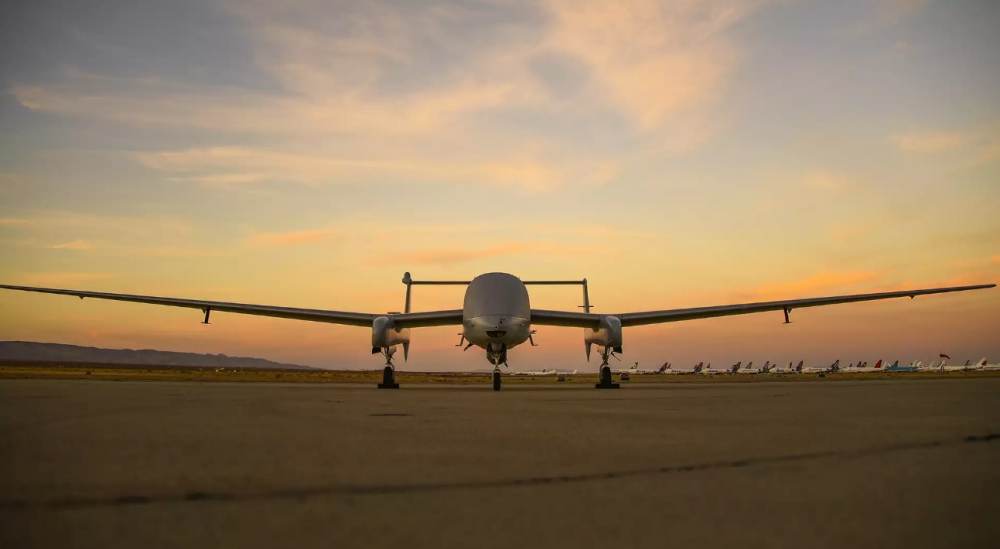One of the most exciting developments in aerial surveillance isn’t happening at some shadowy Air Force Base in the middle of Nevada desert, it’s occurring at Mojave Air and Space Port, a bustling bastion of aerospace creativity, located 50 miles to the southeast of Bakersfield, California. There, Northrop Grumman is working hard to make Medium Altitude, Long Endurance (MALE) unmanned aircraft capabilities accessible to a far larger global customer base than what exists today.
They believe this lofty goal can be achieved by bringing an optionally manned, highly unique looking aircraft to the marketplace. That aircraft is the Northrop Grumman Firebird, a plane whose obscure development we here at The War Zone followed intensely, albeit from a distance, as nobody in an official capacity has been willing to discuss it—that is until now.
The concept is as bewilderingly logical as it is downright exciting—create an aircraft that can fly very efficiently at medium altitudes for very long periods of time while also possessing the ability to swoop down below bad weather if need be. Ideally, this aircraft would also carry a wide variety of sensor and communications payloads, many of which can be outfitted concurrently during a single mission. These payloads would also have to be rapidly reconfigurable in the field, allowing for a single aircraft to accomplish disparate mission types simultaneously. But above all else, this transformer of a flying machine would need to be able to go from manned to unmanned operations in just a handful of hours.
All this is precisely what Firebird was built to do.
The Firebird concept actually dates the back to the latter half of the 2000s, with Scaled Composites, Northrop Grumman’s storied subsidiary, eventually building a technology demonstrator. That highly experimental aircraft was a forerunner to the current Northrop Grumman designed Firebird, which is a clean-sheet, production-ready aircraft. Scaled Composites’ Firebird demonstrator first flew in 2010 and proved that an optionally manned, highly flexible surveillance aircraft could not only work, but it could compete for missions with both unmanned and manned platforms at the same time and win on both fronts.
The current Firebird’s greatest trick is its ability to transform in the field. It can go from manned to unmanned mode in just four hours. The process of converting the aircraft is remarkably straightforward. A Northrop Grumman official described the process to us in detail, stating:
“It’s a Garmin glass cockpit, with a standard three screen display. One of the really interesting things about the way that we designed the cockpit is that the ground station is highly similar. It’s very easy for the pilot to transition from flying in the aircraft to flying it from the ground. It’s also easy to transition from manned to unmanned mode. That is a four hour flop, with very simple mechanical and electronic interfaces. There is only a handful of them and they are very straightforward.
The flight test program continues to demonstrate the full capability of the system. We have flown both manned and unmanned now, and are continuing to mature the system, switching between manned and unmanned operations almost daily. We actually flew UAV, did a software update the following day and flew manned with the new software load. Even in the test phase, we’re really reaping the benefits of that flexibility.
When we go into the unmanned mode what happens is the canopy comes off, the seats come out, the instrument panel comes out. A B-LOS (Beyond Line Of Sight) dish goes in and a bigger canopy to cover the dish goes in. Again, it’s a very simple interface.”
Firebird’s ability to rapidly convert from a manned to an unmanned aircraft opens up a whole new universe of flexibility. Just being able to self-deploy an aircraft with MALE capabilities to forward operating locations by having a pilot onboard solves many issues that dog relatively advanced unmanned aircraft till this very day.
Unlike its unmanned counterparts, Firebird doesn’t need to be able to be broken down and stuffed in ‘caskets’ before being loaded onto an airlifter and flown to where it is needed—an expensive and logistically complex affair that is outside the budgets of many potential customers that have a need for MALE capabilities.
Also, because of its ability to self-deploy, it seems as if Firebird ‘s designers weren’t constrained by the need to be able to ship the aircraft as a kit. As such, it could be optimized to its fullest potential for its intended operating envelope and mission set. What resulted was an elegant but also hardy twin-tail boom, two-seat design—one that can carry a big and diverse payload while leveraging a relatively pedestrian and comparatively ultra-efficient engine.
Firebird, which is not a small aircraft, with its big wingspan optimized for long endurance missions, runs on a Lycoming TEO-540 engine. This six-cylinder, turbocharged engine packs about 350hp in stock form and runs on the same 100LL avgas as a Cessna 152. In comparison, the General Atomics MQ-9 Reaper/Predator B uses a Honeywell TPE331-10 turboprop engine, pumping out 900hp and slurping down jet fuel in the process. This alone is maybe the best indicator of just how efficient Firebird is, not just when it comes to doing more with less thrust in relation to raw performance, but also when it comes to overall operating cost. The cost difference of operating a light airplane piston engine compared to a turboprop is substantial.
Beyond the unique logistical challenges of moving unmanned aircraft over great distances and setting up operations in often unfamiliar areas, the flexibility of being able to fly manned or unmanned mission profiles based on the customer’s mission needs, the operating environment, and even their budget has the potential to be truly revolutionary.
The reality is that unmanned aircraft operations—at least the traditional kind where there are people “in the loop” flying the aircraft and operating its sensors via data-link—is not a cheap or simple affair. With man-in-the-loop operating concepts, unmanned aircraft are actually very much manned and quite expensive to operate when you factor in all the support infrastructure that is essential to bringing the capability to life. The fact that a pilot can just jump in Firebird and cut most of that infrastructure out of the cost-equation while still leveraging many of the aircraft’s unique benefits, efficiencies, and capabilities, is huge.
The Northrop Grumman official we talked to about Firebird made it clear that price point and flexibility will be the major drivers in making the program a success:
“It’s a capability that’s truly new in the space. And what we believe is a really competitive price point that’s going to allow us to provide an ISR capability so more customers can better have access to this level of capability than ever before. The key to how we are doing that is through the system flexibility. This is a system that’s all about flexibility.”
Sometimes it is just best to have a person in the cockpit for mission-related situational awareness reasons and it can be essential for flying in crowded and highly regulated airspace. You simply don’t have these options with a strictly unmanned aircraft. Also, when it comes to cost and flexibility, Northrop Grumman built Firebird with very austere operating locales in mind. The aircraft has a hardy landing gear and a tough airframe that allows it to be able to operate from semi-prepared fields, something nearly unheard of among the roster of unmanned aircraft with similar capabilities.
This also means Firebird can be based closer to the action, potentially cutting down on transit times drastically, and as a result also cost, or operators can use that time saved to enhance on-station time.
Payload-wise, Firebird and its open-architecture avionics system is all about moving away from heavily integrated sensors and communications systems and leveraging highly modular components with standard interfaces. As a result, Firebird can be so much to so many people without altering the airframe itself.
The Northrop Grumman official described the Firebird’s modularity in detail:
“We have a sizeable payload bay for an aircraft of this size. It’s 45 cubic feet, fits two 19-inch racks and is really focused on flexibility and multiple payloads for ISR missions. There’s a number of serial and IP interfaces. We’ve demonstrated payload changes in as little as 30 minutes. We’ve demonstrated new payload installations in under a day. We’ve demonstrated over two dozen payloads integrated into this architecture, including EO/IR (Electro-Optical/Infrared), tactical radios, radar, signals and communication payloads, and we’ve also demonstrated operating four payloads simultaneously while imaging different areas.
This is truly a multi-int (multiple intelligence) flexible system. We designed it that way because we envision a broad range of payloads that our customers are going to want to bring to do a number of current and emerging missions across the mission space.”
Being able to pack radar, EO/IR, signals intelligence, and communications payloads all at the same time offers a big multi-spectral view of wherever Firebird is operating over at the time. The ability to exploit all this intelligence concurrently and in near real-time makes it far more impactful than the sum of its parts. This modularity and flexibility mean that one plane can be a lot of different things for different customers too, potentially resulting in a huge return on investment for Northrop Grumman.
Firebird’s potential applications aren’t just military in nature, either. They include commercial, scientific, law enforcement, and other federal agency work, as well. Pushing out over the ocean for maritime surveillance is also a very real possibility for this unique aircraft.
The Northrop Grumman official describes this possibility, along with many others:
“One of the key differences between an over land and an over sea mission is the payloads you put on the plane. And Firebird is designed for payload flexibility. We have de-ice capability and a weather radar in the plane. So it’s designed for all weather, sometimes that can be a concern over the sea.
But when you think about the kinds of ISR needs, it really runs the gamut. From what we view as traditional missions to an emerging need for law enforcement, forest service, environmental missions, scientific ISR and, climate change. Even commercial ISR is becoming a growing market, with oil and gas, pipeline monitoring, and disaster zone monitoring. We’re really thinking about this as a product line because we’re thinking about the broad range of markets that we can touch in that way.
Because it’s such a big market, we’re looking to build an ecosystem of industry partners to help us get access to the enormous amount of global markets this platform is going to be relevant in.”
There are indicators that Northrop Grumman is going to bridge Firebird’s mission flexibility with business model flexibility that will provide potential customers a menu of options for accessing the aircraft and modular payload components to fly on it. Selling aircraft outright in a traditional sense is still an option, but being able to lease the aircraft on multiple levels could also be highly attractive for less cash-rich customers or for those who just are not in need of large enough ISR capacity that would necessitate standing up a dedicated fleet of aircraft.
As for Firebird’s aforementioned flight testing, it is proceeding at a quick pace with two aircraft now in the test program. According to our sources, the aircraft is already exceeding many of its design goals, but it’s still early on in the testing process. If everything goes as planned, the aircraft will be in a totally different developmental position by the latter half of 2019, at which time we may get some official performance metrics from Northrop Grumman.
Source: The Drive





How about a little more critical analysis, instead of just swallowing everything that Northrop says?
Amen brother!